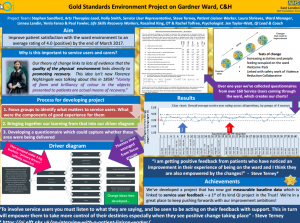
My Quality Improvement Journey…
7th April 2017
Bernadette Tilley, QI Communications and Events management Lead, interviewed Holly Smith; ex service user and QI project team member for Gold Standard Environments, about her QI experiences and journey so far…
I was on Gardner ward as a service user just over a year ago. When I was on the ward I was struck as to how different Gardner ward was compared to other wards I had been on before. There was a lot of room for improvement; as a result, I didn’t have the greatest time on the ward. But, whilst I was there and nearing discharge, one of the ward managers mentioned that they were going to be starting a quality improvement project in order to improve the ward. They asked me to come up with some ideas as to what could be improved.
At that point, I didn’t have a lot to do with my time, so I agreed and put together a list of the improvements that could be made to the ward. Having been a patient on other wards I had seen what was possible. There was quite a lot that other wards had done or were doing that were lacking on Gardner. It was little things that you don’t really think about, but you notice when you are living there for a long period of time.
For example; there were no clocks on the walls of Gardener. That was quite disorientating, when there was no concept of time. It didn’t help me feel things were getting back to “normal” again. Someone delivering care or visiting wouldn’t be impacted by a lack of clocks in the same way. Another little thing was not having a hair tie for long hair. It sounds like such a small thing, but, I have quite long hair, and it quickly gets very frustrating when it is constantly in the way; I was constantly dipping it in meals or paint. You can get 100 for £1 in Primark; they’re not difficult or expensive to get hold of and yet they can make so much difference.
The quality improvement project; Gold standards on Gardner ward, is aiming to provide a 3 star + level of care, it’s a bit like the rating for hotels. This is a very broad piece of work as it is trying to improve the overall experience of a service user’s time on the ward. It covers so many areas! We will be measuring using satisfaction surveys from service users. In order to get the most accurate data we have spent a year refining how we collect the right feedback, so there has been a lot of work around designing the satisfaction survey; what questions we ask service users, how we frame them, the categories of questions and also providing service users with the opportunity to expand on answers where needed. All this has been groundwork in preparation to start our measurement phase of the project and collect data. We’ll be testing our change ideas and gathering data throughout 2017.
So, why did I get involved in the first place?
Well, having been a patient and being on the receiving end of care I wanted to help. As mentioned earlier, I know how much a few small things can make a real difference to someone when they’re feeling very vulnerable and being cared for. With small changes it is easy to raise the standard of care on a ward and directly impact a person’s experience of being there. Little things can go a long way to helping recovery on a mental health ward.
I also needed something to challenge me straight after being discharged, so I got involved straight away. It meant that my experiences of being a patient on the ward were fresh and I could a unique perspective of what it is like to be on the receiving end of care and what is good or bad. I went with the project team to Alie Street to make an impact on the directors who were interested in the project.
As to fitting in this extra work into my schedule – I haven’t had any problems. My role is advisory and making sure the aim of the project and perspectives are right. I am able to dial into meetings too, so I don’t have to make long journeys to join the team. It’s quite flexible.
Professionally I have experience of project management; quality improvement methodology is a little bit different, but it’s been very interesting using these methods and there have been occasions in my own job where I have used these methods, for example, in planning sessions where there have been loads of ideas floating round and it’s difficult to sort them out, I have used nominal group technique with my team and analysed the ideas using an affinity diagram.
B ased on my experience of QI, I believe the role of the service user should be reminding the team what the key focus is for their work and what the objectives are of the whole project. Service users can also offer a unique perspective on whether suggestions and changes will actually help, as they know what it’s like to be on the receiving end of care. I think this input helps keep the team grounded and remember that they are doing this all to help the service user. A working example of this on our project has been staff wanting to add magazines in wards. It sounds like a good idea, but some magazines sell ideas of what the ideal body image is, or how you should look, or perhaps buying or having certain things will make you happy, popular or find love. To a vulnerable person having a tough time on a mental health ward and trying to recover, these subliminal messages are unhelpful. So it is better from a service user point of view to have magazines that focus on positive messages, such as health and wellness, hobbies etc.
ased on my experience of QI, I believe the role of the service user should be reminding the team what the key focus is for their work and what the objectives are of the whole project. Service users can also offer a unique perspective on whether suggestions and changes will actually help, as they know what it’s like to be on the receiving end of care. I think this input helps keep the team grounded and remember that they are doing this all to help the service user. A working example of this on our project has been staff wanting to add magazines in wards. It sounds like a good idea, but some magazines sell ideas of what the ideal body image is, or how you should look, or perhaps buying or having certain things will make you happy, popular or find love. To a vulnerable person having a tough time on a mental health ward and trying to recover, these subliminal messages are unhelpful. So it is better from a service user point of view to have magazines that focus on positive messages, such as health and wellness, hobbies etc.
My impression of quality improvement in the project I’m involved in is that staff have found and are finding this work incredibly valuable. They are not dictated to from the top. They chose to do the project, and it has all come from them. These are busy frontline staff who are passionate about their work and the care they deliver to patients. I think that’s one of the most important aspects of improvement work; staff need to buy in to QI. There’s a created and shared responsibility within the project team to keep things going. e.g. safety huddles; these are more likely to succeed due to created responsibility.
It’s so important to get service user input in quality improvement work, project teams will find it very valuable. However, it’s important to remember that service users cannot be around 24/7 and for the whole duration of an improvement project. Some may only want to help for a certain period of time, and that’s OK. It’s still great to use them and their skills to help you! You may want a service user to give you feedback on one survey question, or provide ideas for one particular aspect of your project. They may have a particular interest or skill with that you can utilise in the overall project. So, involve them! It’ll still be a valuable and rewarding experience for them and you!
Click on the picture below to view the latest progress of Gold Standard Environments QI Project, presented at the 2017 QI Conference
Most Read Stories
-
Why is Quality Control important?
18th July 2018

-
An Illustrated Guide to Quality Improvement
20th May 2019

-
2016 QI Conference Poster Presentations
22nd March 2016
-
Recognising Racism: Using QI to Help Take Action
21st January 2021

-
Using data enabled us to understand our problem
31st March 2023

-
QI Essentials: What does a Chief Quality Officer do?
18th March 2019


Follow QI on social media
To keep up to date on the latest concerning QI at ELFT, follow us on our socials.




